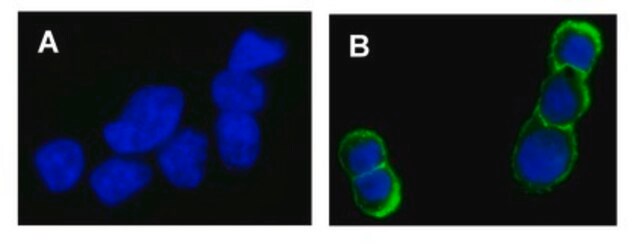SAB1404522
Anti-Vinculin Antibody
mouse monoclonal, 3F8-1D4
Synonim(y):
CMD1W, MVCL
About This Item
Polecane produkty
product name
Monoclonal Anti-VCL antibody produced in mouse, clone 3F8-1D4, purified immunoglobulin, buffered aqueous solution
pochodzenie biologiczne
mouse
Poziom jakości
białko sprzężone
unconjugated
forma przeciwciała
purified immunoglobulin
rodzaj przeciwciała
primary antibodies
klon
3F8-1D4, monoclonal
Postać
buffered aqueous solution
masa cząsteczkowa
antigen ~143.26 kDa
reaktywność gatunkowa
human
metody
capture ELISA: suitable
immunofluorescence: suitable
indirect ELISA: suitable
western blot: 1-5 μg/mL
izotyp
IgG2bκ
numer dostępu NCBI
numer dostępu UniProt
Warunki transportu
dry ice
temp. przechowywania
−20°C
docelowa modyfikacja potranslacyjna
unmodified
informacje o genach
human ... VCL(7414)
Opis ogólny
Immunogen
Sequence
MPVFHTRTIESILEPVAQQISHLVIMHEEGEVDGKAIPDLTAPVAAVQAAVSNLVRVGKETVQTTEDQILKRDMPPAFIKVENACTKLVQAAQMLQSDPYSVPARDYLIDGSRGILSGTSDLLLTFDEAEVRKIIRVCKGILEYLTVAEVVETMEDLVTYTKNLGPGMTKMAKMIDERQQELTHQEHRVMLVNSMNTVKELLPVLISAMKIFVTTKNSKNQGIEEALKNRNFTLEKMSAEINEIIRVLQLTSWDEDAWASKDTEAMKRALASIDSKLNQAKGWLRDPSASPGDAGEQAIRQILDEAGKVGELCAGKERREILGTCKMLGQMTDQVADLRARGQGSSPVAMQKAQQVSQGLDVLTAKVENAARKLEAMTNSKQSIAKKIDAAQNWLADPNGGPEGEEQIRGALAEARKIAELCDDPKERDDILRSLGEISALTSKLADLRRQGKGDSPEARALAKQVATALQNLQTKTNRAVANSRPAKAAVHLEGKIEQAQRWIDNPTVDDRGVGQAAIRGLVAEGHRLANVMMGPYRQDLLAKCDRVDQLTAQLADLAARGEGESPQARALASQLQDSLKDLKARMQEAMTQEVSDVFSDTTTPIKLLAVAATAPPDAPNREEVFDERAANFENHSGKLGATAEKAAAVGTANKSTVEGIQASVKTARELTPQVVSAARILLRNPGNQAAYEHFETMKNQWIDNVEKMTGLVDEAIDTKSLLDASEEAIKKDLDKCKVAMANIQPQMLVAGATSIARRANRILLVAKREVENSEDPKFREAVKAASDELSKTISPMVMDAKAVAGNISDPGLQKSFLDSGYRILGAVAKVREAFQPQEPDFPPPPPDLEQLRLTDELAPPKPPLPEGEVPPPRPPPPEEKDEEFPEQKAGEVINQPMMMAARQLHDEARKWSSKGNDIIAAAKRMALLMAEMSRLVRGGSGTKRALIQCAKDIAKASDEVTRLAKEVAKQCTDKRIRTNLLQVCERIPTISTQLKILSTVKATMLGRTNISDEESEQATEMLVHNAQNLMQSVKETVREAEAASIKIRTDAGFTLRWVRKTPWYQ
Postać fizyczna
Oświadczenie o zrzeczeniu się odpowiedzialności
Nie możesz znaleźć właściwego produktu?
Wypróbuj nasz Narzędzie selektora produktów.
polecane
Kod klasy składowania
10 - Combustible liquids
Klasa zagrożenia wodnego (WGK)
WGK 1
Temperatura zapłonu (°F)
Not applicable
Temperatura zapłonu (°C)
Not applicable
Certyfikaty analizy (CoA)
Poszukaj Certyfikaty analizy (CoA), wpisując numer partii/serii produktów. Numery serii i partii można znaleźć na etykiecie produktu po słowach „seria” lub „partia”.
Masz już ten produkt?
Dokumenty związane z niedawno zakupionymi produktami zostały zamieszczone w Bibliotece dokumentów.
Nasz zespół naukowców ma doświadczenie we wszystkich obszarach badań, w tym w naukach przyrodniczych, materiałoznawstwie, syntezie chemicznej, chromatografii, analityce i wielu innych dziedzinach.
Skontaktuj się z zespołem ds. pomocy technicznej